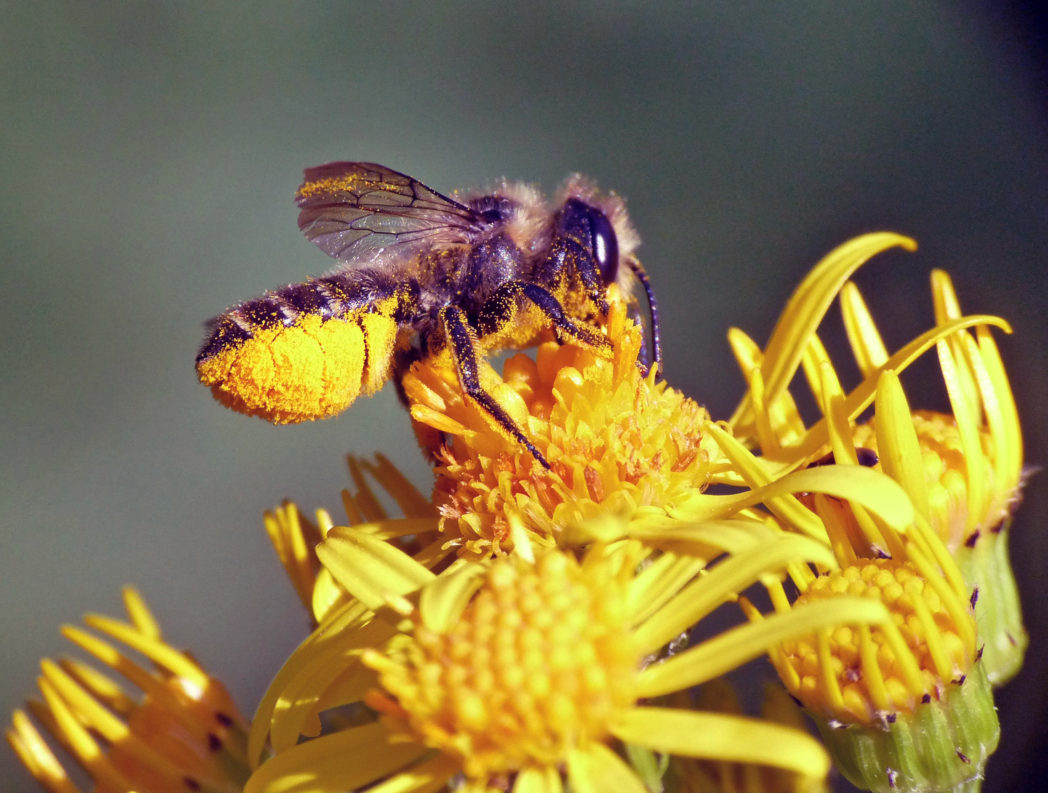Leafcutter bees
by Jonnie Dietz, Florida Museum of Natural History.
“Know your native pollinators” is a series of articles that will help you identify and appreciate Florida’s varied pollinators, including bees, wasps, butterflies, moths, beetles, flies, birds and bats. Pictured above: Megachile sp. on carrying pollen on her abdomen. Photo courtesy of Ian Boyd (CC BY-NC 2.0).
Megachilidae (commonly referred to as leafcutter, mason, orchard or cuckoo bees) are a large family of solitary nesters with distinctive and fascinating behaviors. Many are easily recognizable and can be attracted to your yard with artificial nesting boxes.
CLASSIFICATION
Class: Insecta
Order: Hymenoptera
Family: Megachilidae
FORAGING PREFERENCES
Megachilidae is a diverse group of bees, with more than 4,000 species worldwide. This large family contains both generalists and specialists, but they’re most often seen foraging on Asteraceae (daisy or aster family), Fabaceae (pea or legume family), Lamiaceae (mint family) and Rosaceae (rose family).
Some specific examples upon which Megachilidae have been spotted foraging are:
- Spanish needles (Bidens alba)
- Dune sunflower (Helianthus debilis)
- Purple thistle (Cirsium horridulum)
- Eastern milkpea (Galactia volubilis)
- Canadian germander (Teucrium canadense)
- Turkey tangle fogfruit (Phyla nodiflora)
- Beardtongues (Penstemon spp.)
- Pricklypear cactus (Opuntia spp.)
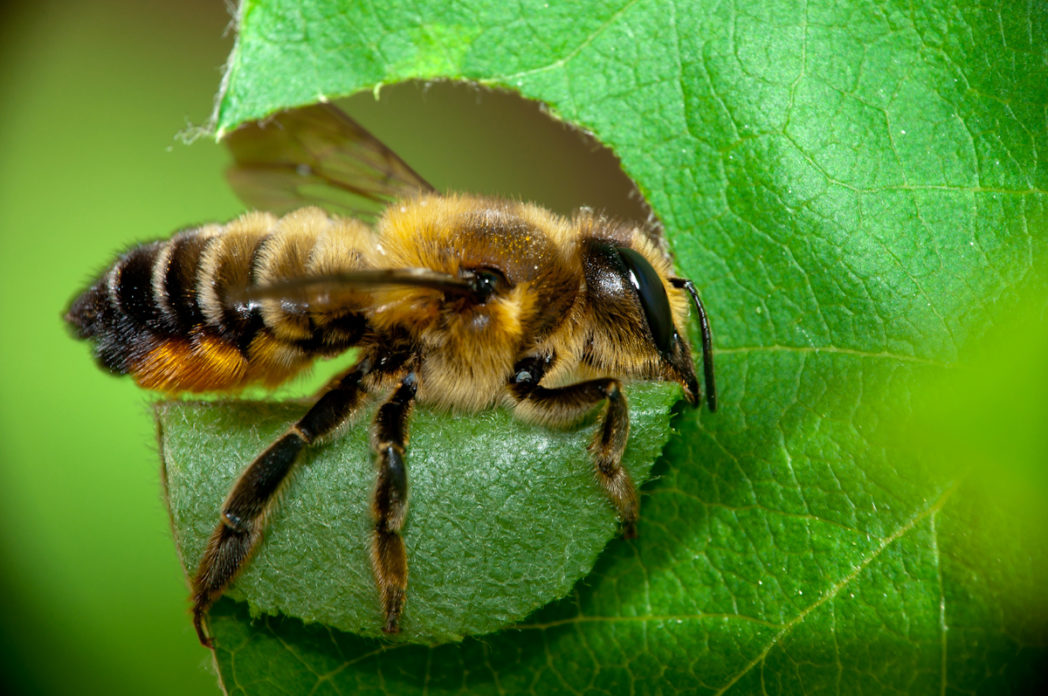
Megachile sp. cutting a leaf with its mandibles. Photo courtesy of JRxpo (CC BY-SA 2.0).
IDENTIFICATION
Stripes, spots and iridescent colors are just a few of the stunning features that decorate this large family of solitary nesters. Most use foreign materials to build, line, partition and seal their nest cells. Many have large mandibles (jaws) which aid in nest-building tasks, such as chewing leaves and stems, and transporting pebbles to nests.
While most bees carry pollen on their legs, the majority of Megachilidae have pollen-collecting structures on the underside of their abdomens (see photo above). If you spot a bee with bright yellow or white pollen on her belly, you can be sure it belongs to this family.
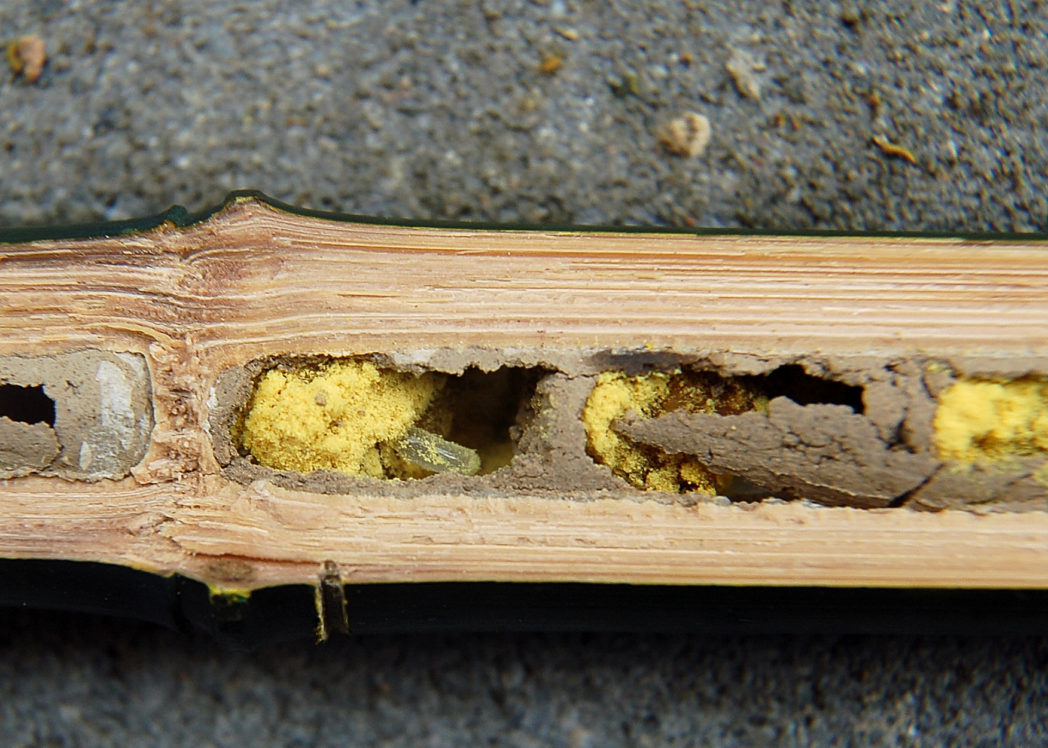
Inside a mason bee (Osmia sp.) nest. Photo courtesy of tpjunier (CC BY 2.0).
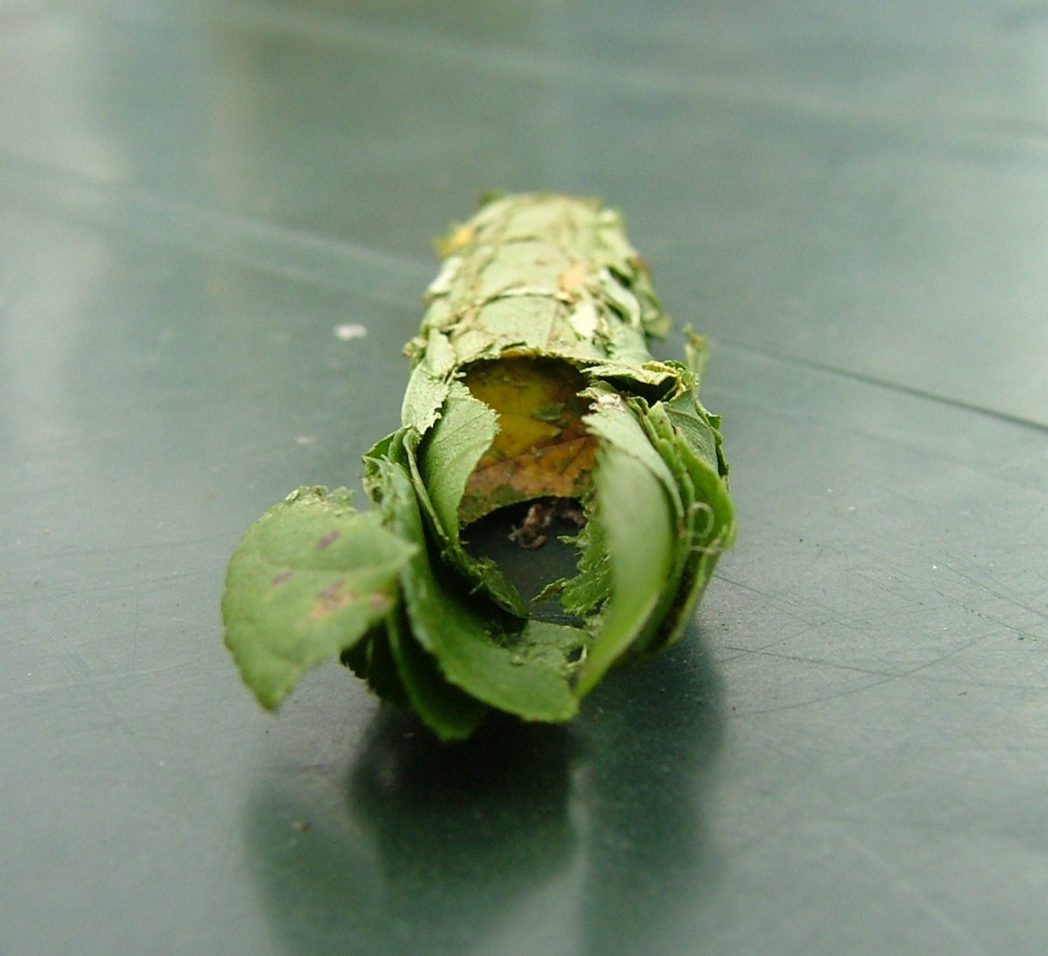
Nest of a leafcutter bee. Photo courtesy of Simon Edge (CC BY-NC-ND 2.0).
LIFE CYCLE
Megachilidae are solitary nesters, but there is no one ideal place for these bees to make a home. Worldwide, this family demonstrates a wide variety of nesting behaviors, occupying spaces such as empty snail shells, spaces between roof shingles, insides of metal pipes, abandoned nests in the ground, and burrows in dead wood.
Resin and pine sap are collected by some species to glue together snippets of plant material. Other species are masons, building their nests with mud and pebbles in the cracks and crevices between rocks or in premade holes in wood. Still others will dig tunnels in the ground, and a few even bore their own holes into dead wood.
Florida Megachilidae
Florida is home to about 75 species of Megachilidae bees, so we’ll only talk in depth about the most commonly spotted genera. These include bees in genus Megachile, Osmia and Coelioxys.
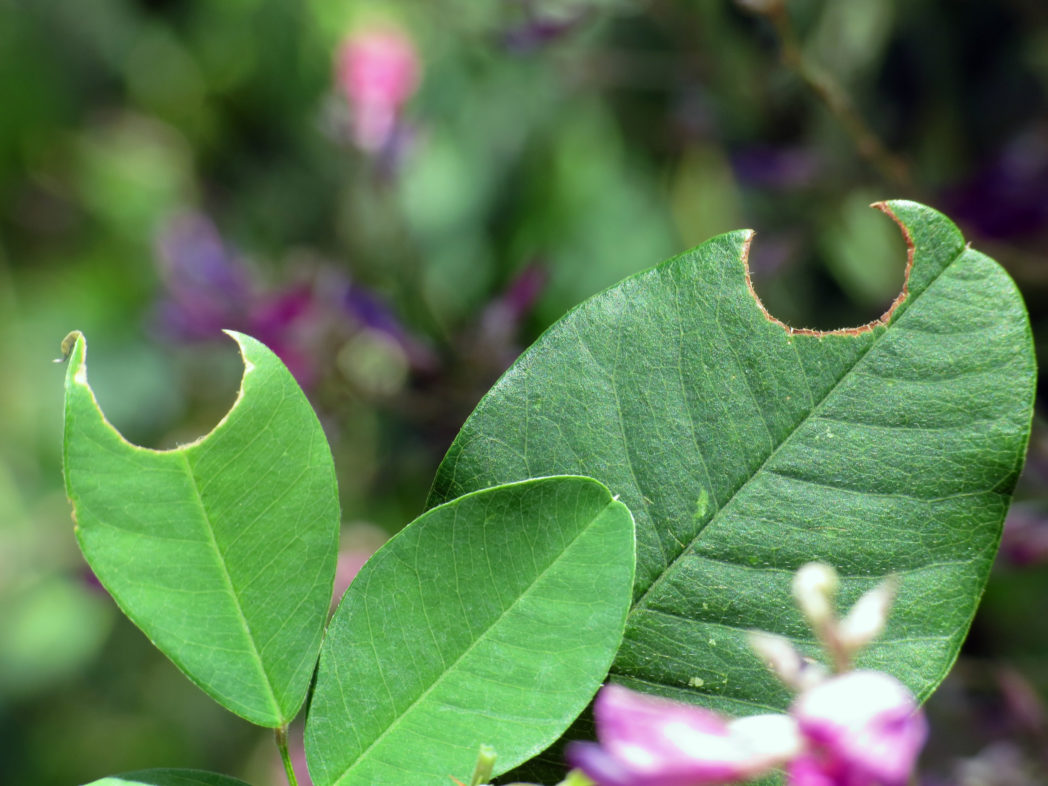
Notches in bushclover leaves cut by Megachile sp. Photo courtesy of Jonnie Dietz.
Genus: Megachile (Leafcutter bees)
Most Florida Megachilidae belong to this genus. They are medium-sized bees, usually black in color with white hairs, and fly from spring to late fall. Leafcutters get their name from the almost perfectly round holes that they chew in leaves and flower petals.
At first glance, gardeners may fear there’s a hungry pest in their midst, but these plant pieces are not used for food. Instead, the collected material is essentially used as a wallpaper to protect the Megachile nest cells from moisture. Once inside her nest, the bee chews the leaf’s edges until it becomes sticky enough to adhere to the cell walls. Each cell is provisioned with a mixture of pollen and nectar and partitioned with additional plant material. If you were to remove a completed nest from its cavity, it would resemble a small, leafy cigar.
Leafcutters tend to nest in premade cavities in wood, such as beetle burrows, hollow stems and artificial nesting boxes. Some, however, nest in the ground or use alternative materials such as mud, sap or pebbles to line their cells.
Note: Holes cut by leafcutters rarely compromise the health of a plant, so gardeners can take pride in knowing they have pollinators nesting nearby!
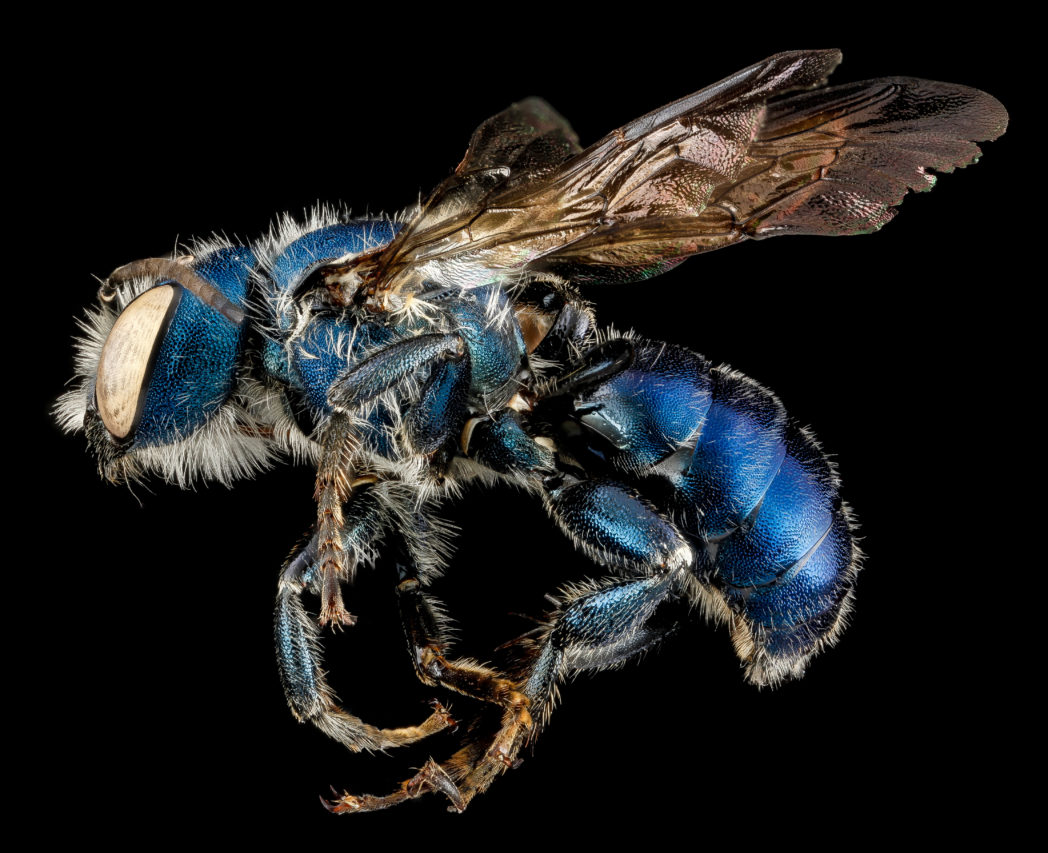
Osmium chalybea. Photo courtesy of USGS Native Bee Inventory and Monitoring Laboratory.
Genus: Osmia (Mason or Orchard bees)
Often referred to as mason bees, most bees in this genus are a bright iridescent blue, green or black. Once again, their name is a descriptor of their nest-building behavior. Most use mud to line their nest cells, but others will use chewed plant materials.
These bees prefer to find premade holes in which to build their nests, including hollow stems, pine cones, cracks in rock or artificial nesting boxes. Others will use pebbles and mud to construct a nest on the surface of rock or other hard surface. In general, nest cells are partitioned with mud or plant material and each cell is each provisioned with a ball of pollen and nectar.
Keep a vigilant eye out for these beautiful bees, as they typically have a short flying season that only lasts from spring through early May.
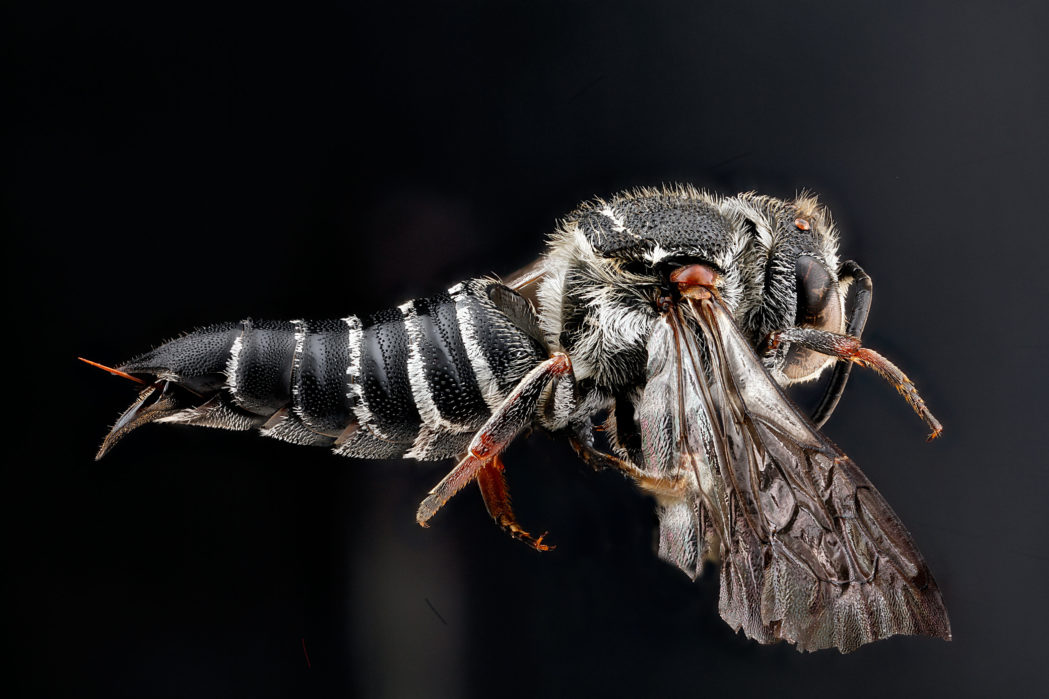
Note the tapered abdomen of Coelioxys sayi, a kleptoparasitic bee. Photo courtesy of the USGS Native Bee Inventory and Monitoring Laboratory.
Genus: Coelioxys (Cuckoo bees)
These bees are kleptoparasites. Instead of building their own nests, they will locate and parasitize the nests of other bees in the Megachile genus. Because they don’t provision for their own young, adult cuckoo bees have no pollen-carrying structures on their bodies and are significantly less hairy. Their extremely tapered abdomens are designed to pierce through the leafy nest cells of Megachile bees, where the Cuckoo bee will then lay an egg. Once the Coelioxys larvae hatches, it kills the resident leafcutter larvae and consumes its food provisions. These bees may not have to make and provision their own nests, but they are completely dependent upon other species for their survival.
Other Florida genera
Other Florida Megachilidae genera include Lithurgus, Anthidium, Stelis, Trachusa, Paranthidium, Anthidiellum, Dianthidium, Heriades, Ashmeadiella and Hoplitis.
In general, bees in these groups are less common and less widely distributed than those in the three genera featured above, but they are no less intriguing. We just couldn’t leave them out entirely, so here’s a quick fact about each one:
- Lithurgus: There is only one known species in Florida: Lithurgus gibbosus. They specialize on prickly pear cactus (Opuntia spp.) and are found nesting in dry wood.
- Anthidium: There is only one known species in Florida: Anthidium maculifrons. This soil-nesting species collects plant hairs and pebbles for nest construction.
- Stelis: These bees parasitize other Megachilidae bees.
- Trachusa: These are ground-nesting bees that dig their own burrows.
- Paranthidium: These ground-nesters dig their own burrows in sandy soil and collect resin and gum to partition the nest cells.
- Anthidiellum: This genus prefers open nests that they construct with resin.
- Dianthidium: These bees build exposed nests by gluing pebbles together with resin.
- Heriades: Bees of this genus are small, ranging from 4 mm to 7 mm in size.
- Ashmeadiella: Ranging from 3.5 mm to 9.5 mm in size, this genus usually nests in stems or preexisting holes in wood.
- Hoplitis: These bees build their nests in pithy stems.
References:
- The Bees of Florida. John B. Pascarella, Ph.D., Dean of the College of Sciences, Professor of Biological Sciences, Sam Houston State University, Huntsville, Texas. http://entnemdept.ufl.edu/HallG/Melitto/Intro.htm
- Michener, Charles D. The Bees of the World. Baltimore: Johns Hopkins U Press, 2010. Print.
- “Florida’s Native Bees.” Jaime Pawelek. http://www.floridasnativebees.com
- Mitchell, Theodore B. Bees of the Eastern United States, Volume 2. Raleigh, NC: Published by the North Carolina Agricultural Experiment Station with Support from the National Science Foundation, 1962. Print.
- Wilson, Joseph S., and Olivia Messinger Carril. The bees in your backyard: a guide to North America’s bees. Princeton: Princeton U Press, 2016. Print.
- The Xerces Society. Attracting Native Pollinators: The Xerces Society Guide to Conserving North American Bees and Butterflies and Their Habitat. North Adams, MA: Storey Pub., 2011. Print.

